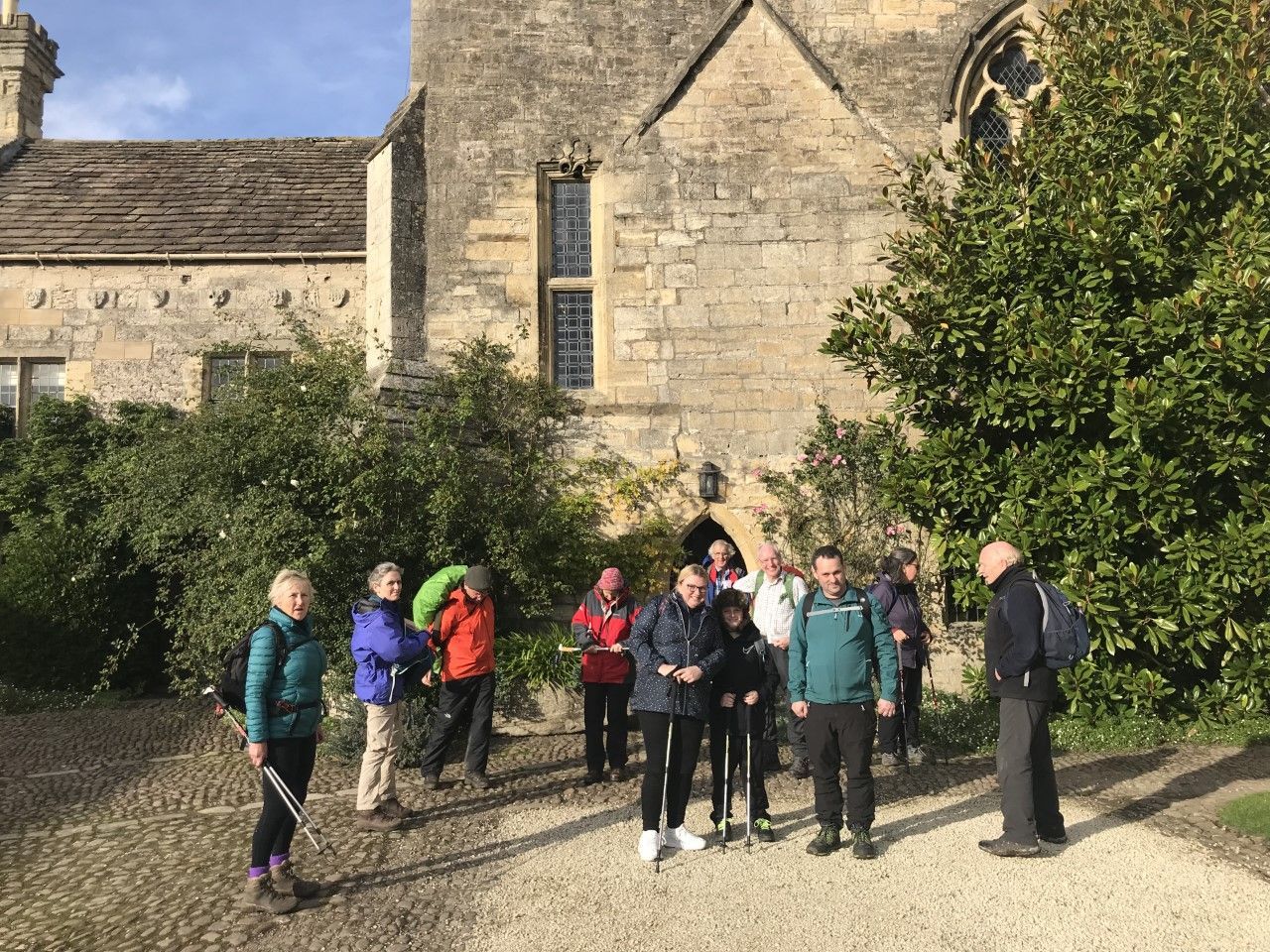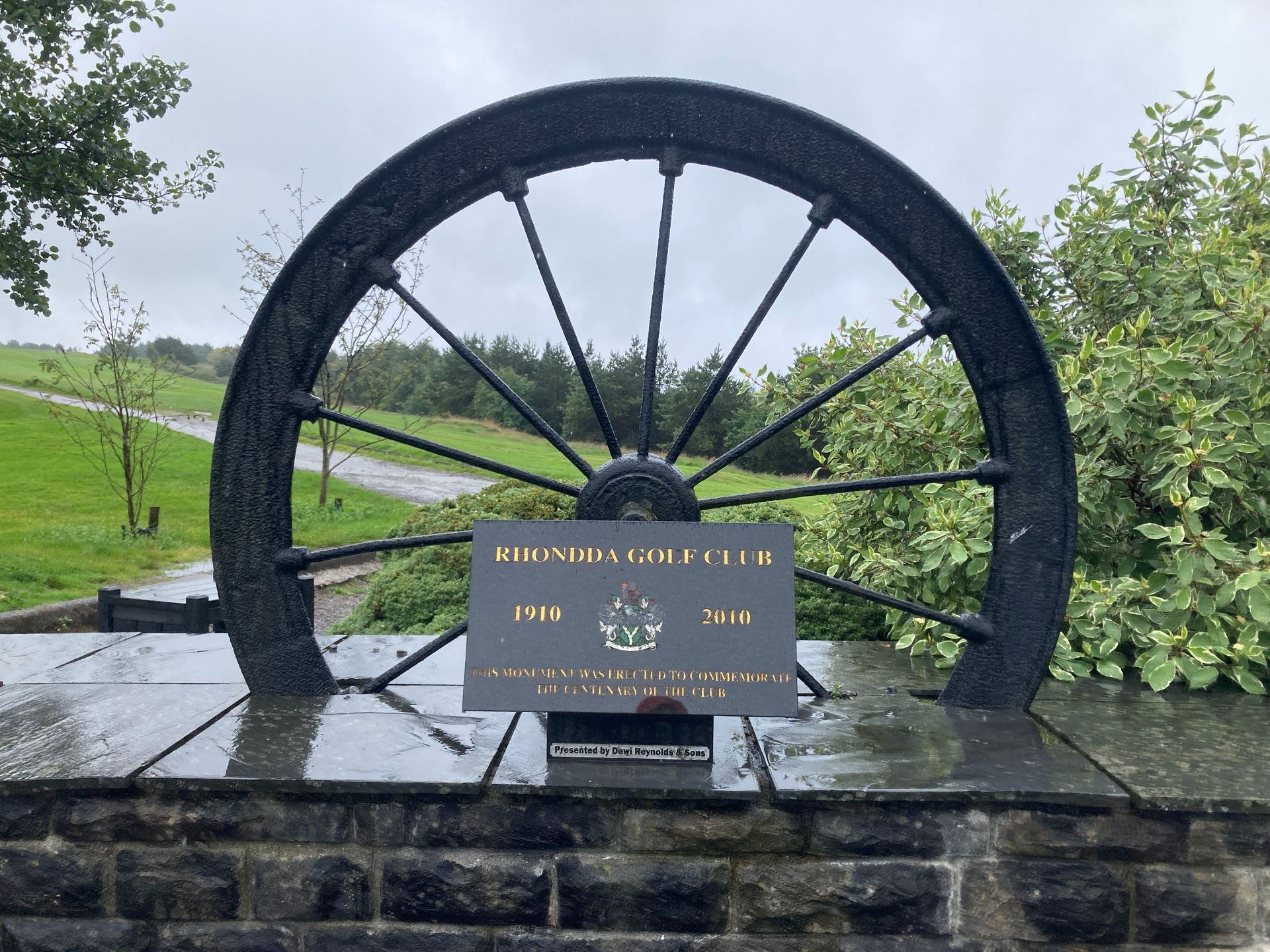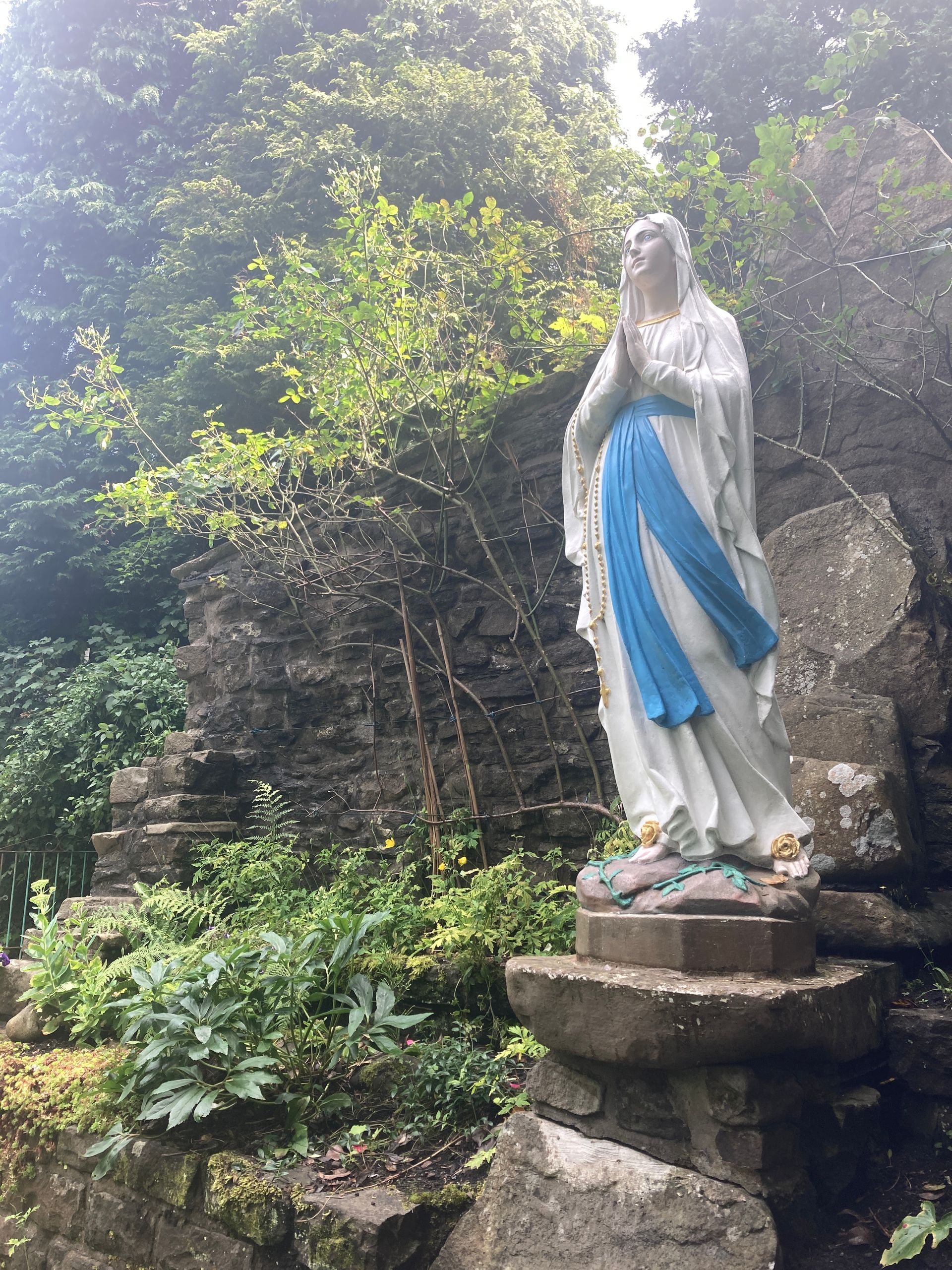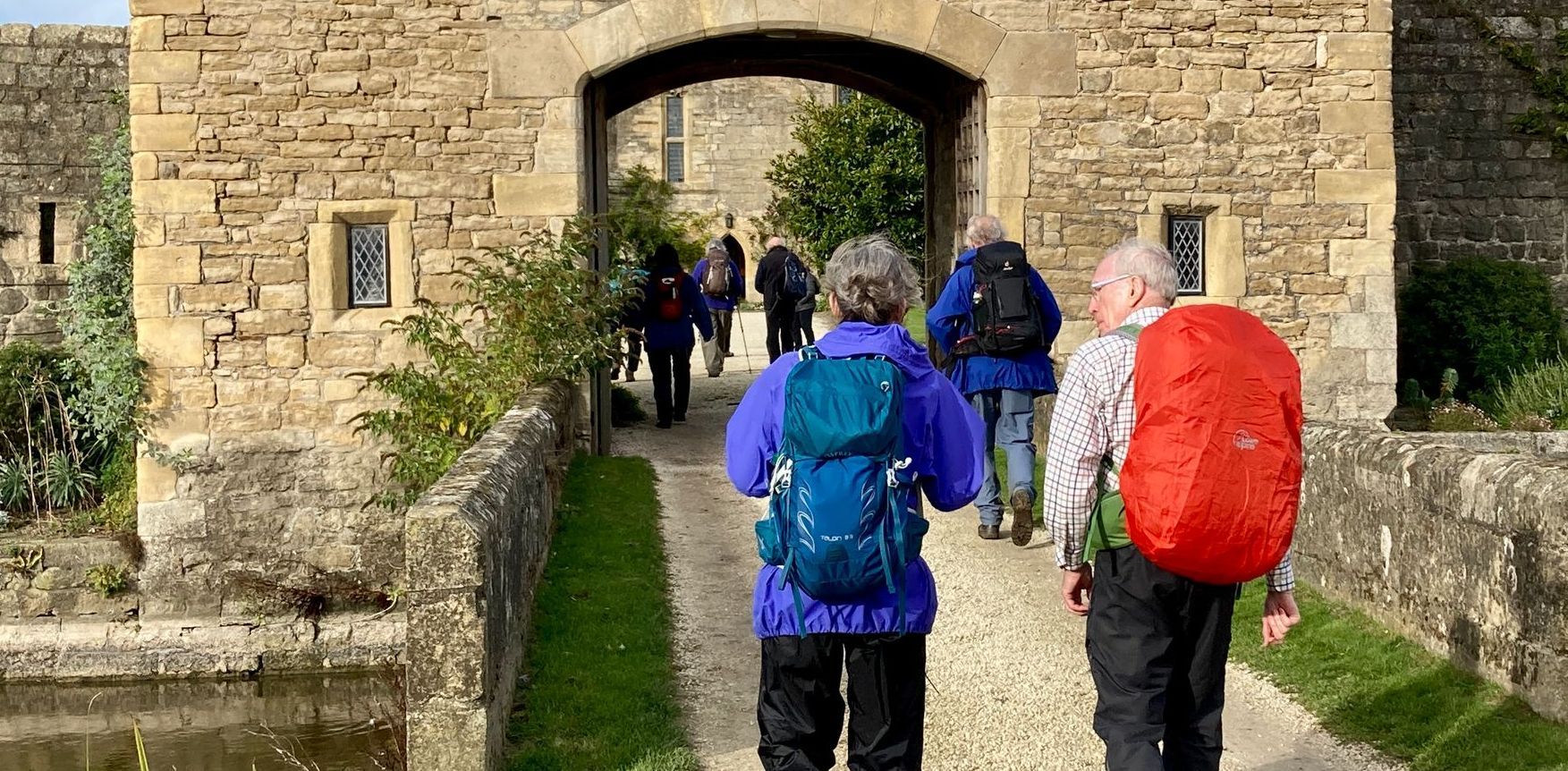The Way of Our Lady of the Valleys
A Pilgrim Way for the Archdiocese of Cardiff-Menevia from the Metropolitan Cathedral of St David in Cardiff to the Shrines to Our Lady at Penrhys & Abercynon
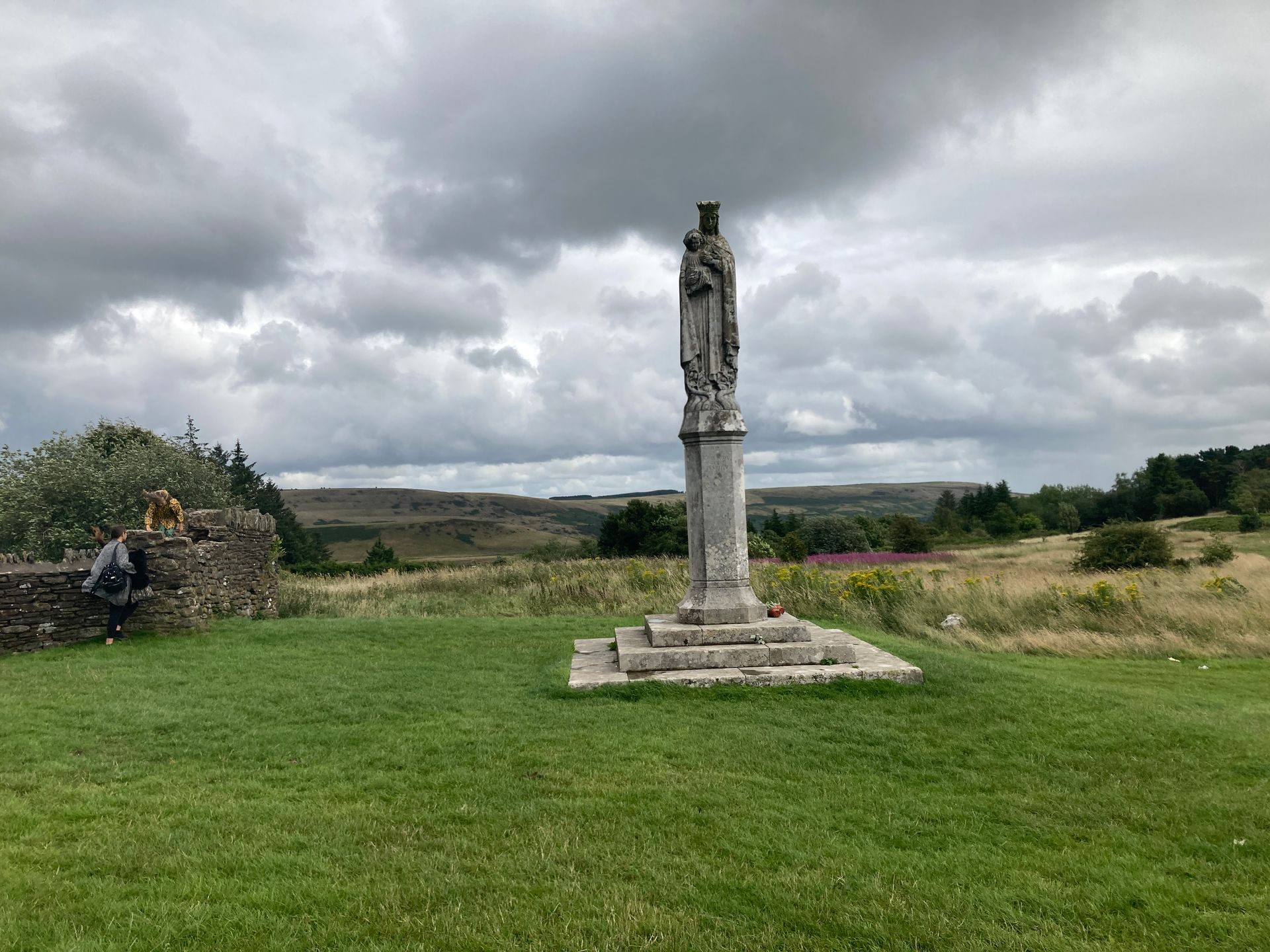
The Shrine of Our Lady of Penrhys
New Paragraph
About the route and the Penrhys Pilgrimage Way
The Shrine at Penrhys was important in medieval times and a popular pilgrimage site. It was destroyed at the Reformation but reinstated in 1953. In contrast the Shrine at Abercynon was built by unemployed Irish and Italian coal miners in 1926.
Between Llandaff Cathedral and Penrhys the Way follows the well-established and waymarked Penrhys Pilgrimage Way (more details below). The Hearts in Search of God project is grateful for the encouragement and collaboration of the Penrhys Pilgrimage Way team. For more information about the Penrhys Pilgrimage Way click on the button below.
From the Shrine at Penrhys the Way descends to the Rhondda Valley and crosses the hills through the St Gwynno Forest. The Way ends at the Shrine to Our Lady in Abercynon, known as the 'Welsh Lourdes' and the adjacent open air Stations of the Cross at the Church of St Thomas near the confluence of the Taff and Cynon river valleys.
You can find out more about the Way and download the GPX file by clicking on the LEARN MORE tab in the
interactive map below
Guidance
Using the tabs in this section you can find the information you need for your pilgrimage.
The Outer Way provides practical advice about the route.
The Inner Way describes the spiritual highlights.
Using the button below you can download details of the inner and outer ways and the walking guidance and maps.
Stages: route, food & drink, accommodation and public transport
NB the numbering of the stages matches those of the Penrhys Pilgrimage Way.
• The Cathedral Way: St David’s Cathedral, Cardiff to Llandaff Cathedral: 3.0 miles
The route passes Cardiff Castle and follows the Cambrian Way beside the River Taff through the pleasant Bute Park almost to Llandaff Cathedral. There are plenty of shops, pubs, restaurants and accommodation in central Cardiff as well as coach and railway stations. In Llandaff there are shops, cafés, pubs and restaurants in the High Street. There are buses back to central Cardiff from the Black Lion stop near the junction of Llandaff High Street with Cardiff Road.
1. Llandaff Cathedral to Radyr: 2.5 miles
From Llandaff Cathedral the path is through woodland to reach the village of Radyr. In Radyr there are shops and cafés in Station Road, Windsor Gardens and Park Road. There may be Airbnb accommodation in the village. There is a railway station with regular trains back to Cardiff.
2. Radyr to Groesfaen: 4.6 miles
The Way follows lanes to cross the M4 but then is on paths through gentle, rolling countryside. There is a pub in Creigiau and a small supermarket in Cardiff Rd. There is also a pub in Groesfaen. There are buses to Cardiff from outside the Babell Chapel in Groesfaen.
3. Groesfaen to Llantrisant: 3.8 miles
The Way is gentle on paths and lanes before a short but steep final ascent to Llantrisant. There is a hotel and restaurant on the main road near Llantrisant and shops, pubs and cafés in the village. There are buses to Cardiff from Southgate, Llantrisant.
4. Llantrisant to Tonyrefail: 3.9 miles
A delightful walk through quiet countryside. NB There is a temporary deviation along the old railway line path (see notes). The Countryman Inn is no longer a pub but does provide b&b accommodation. The route reaches an estate on the outskirts of the former mining village of Tonyrefail. From the end of the route for all facilities continue along Investiture Place (which becomes Concorde Drive) to the main road. Then walk down the hill and take the first R turn into a pedestrianised road that leads to the High St with shops, cafés and pubs. There may be Airbnb accommodation in Tonyrefail. There are buses from the Leisure Centre to Pontyclun station for trains to Cardiff.
5. Tonyrefail to Dinas Rhondda station: 3.6 miles
The route rises and becomes wilder between the villages. In Trebanog there is a pub (closed August 2023) and a general store on Rhiwgarn Rd. There are buses from Trebanog to Llandaff on the main road. There is a railway station in Dinas. (NB in August 2023 the railway line through Dinas was being rebuilt and there was a rail replacement bus service. To reach the bus stops from the railway bridge, walk L up Station Rd. At the junction the stop for buses going north is just to the L on the near side of the road. For buses going south cross the road. There is a small store near the N bound bus stop.)
6. Dinas Rhondda station to Our Lady of Penrhys: 1.9 miles
There is a stiff climb from Dinas, then an exhilarating ridge walk with great views on all sides. In Dinas there is a shop on Nile Rd. In Penrhys estate there is a shop, a fish & chip shop and a community café at Llanfair Uniting Church (not open every day). To reach them cross to the other side of the roundabout and follow a footpath up the hill until you see community facilities on your R. There is an open invitation to walkers to call into the Church to rest if it is open. If you need a toilet ask anyone local and they will phone someone will open the church facilities for you. For buses to Cardiff descend to the valley (see instructions in the next section) but at the roundabout do not cross the river, but TL into the centre of the village.
• The Abercynon Way: Our Lady of Penrhys to Abercynon: 6.7 miles
The final section involves 3 strenuous climbs but is well worth it. There is a mix of open country, forestry and woodland. There are buses from Rock Terrace in Mynachdy back to Cardiff. In Abercynon there are cafés and a railway station for trains to Cardiff. NB If you wish to light a candle at the Abercynon shrine you will need to bring your own tea lights and matches.
Public transport links
Trains:
https://www.nationalrail.co.uk/
Coaches:
https://www.nationalexpress.com
Buses:
Pilgrim people and places
Pilgrimage grew in popularity in Wales in the C5&6 with the emergence of native saints such as St David and St Teilo. After the arrival of the Normans in Wales at the end of the C11, sites associated with many of these saints were developed into major pilgrimage centres, some of which claimed international fame. By the C15, the most popular pilgrimage site in south-east Wales was Penrhys where a statue of the Virgin Mary is said to have appeared in the branches of an oak tree near a holy well called Ffynnon Mair (St Mary’s Well). The Shrine chapel was in the care of the Cistercian Abbey of Llantarnam, which benefited from pilgrim offerings. Stone crosses marked the pilgrim route to the Shine and several Welsh poets composed works praising the Virgin and her Shrine at Penrhys.
By 1538 the Shrine was so popular that Thomas Cromwell ordered that the statue be secretly removed, taken to London and burned with the statues of Our Lady of Walsingham and Our Lady of Ipswich. Although the practice of pilgrimage was banned after the Reformation, the footpaths between Cardiff and Penrhys survived, as did the holy well. In 1953, the Catholic Archdiocese of Cardiff installed a new statue of Mary on the site of the Cistercian chapel carved from Portland stone. Pilgrimages and open-air Masses are held.
In 2018 the Penrhys Pilgrimage Project was established to improve the old pilgrimage way from Llandaff to Penrhys and to promote its use. The route is now waymarked, there are and several information boards and details are available at: http://www.penrhyspilgrimageway.wales/
The Metropolitan Cathedral of St David, Cardiff
During penal times Catholics in Glamorgan were served by priests resident at Llanarth Court, Monmouthshire, and by itinerant priests, mostly Jesuit. Many recusants were imprisoned or died in Cardiff gaol. In the C18 Catholics were served from Pyle, then Bristol and Usk. By 1830 the Catholic population of Cardiff had grown and in 1842 a church was opened on Bute Terrace.
In 1882 a new church dedicated to St David was built on Charles Street to designs by Pugin & Pugin. It was built without aisles or a chancel arch, to afford an unobstructed view of the high altar and reredos. In 1897 the interior walls were painted with murals and new stained-glass windows installed. In 1920 St David’s became the Cathedral of the Archdiocese of Cardiff, created in 1916.
In 1941 the Cathedral was badly damaged by incendiary bombs and was not reconstructed until 1953. Pugin & Pugin’s original designs for the bell stage of the tower were realised and the Cathedral was restored and refitted in a plainer modern style. Many of these furnishings did not survive later reordering but there is a fine ceramic Stations of the Cross and good late C19 & early C20 stained glass.
Llandaff Cathedral is the seat of the Anglican Bishop of Llandaff. It is dedicated to SS Peter & Paul, and three Welsh saints: Dubricius (Welsh: Dyfrig), Teilo and Oudoceus (Welsh: Euddogwy). A Norman cathedral was constructed on the site of an earlier church. Severe damage was done in 1400 during the rebellion of Owain Glyndŵr, during the English Civil War when it was overrun by Parliamentarian troops, and again during the Great Storm of 1703.
In 1734 work began on a new cathedral, designed with an Italian temple style edifice for the eastern portion of the building, while leaving the remaining western half in ruins. All trace of this was removed by reconstruction after 1841. Some of the redecoration was done by Pre-Raphaelite artists: there is a triptych painted by Dante Gabriel Rossetti, stained-glass windows by Ford Madox Brown and Willian Morris, and porcelain panels of the Six Days of Creation by Edward Burne-Jones.
In 1941 the Cathedral was severely damaged by a parachute mine. Much of the reconstruction has been done in concrete and sandstone. There is a statue of Christ in Majesty by Jacob Epstein raised above the nave on a concrete arch.
The Shrine of Our Lady of Penrhys
As described above during the medieval period Penrhys was one of Britain’s major pilgrimage sites. In 1912 excavations revealed the location of the original shrine chapel. At the same time Miss M. M. Davies of Llantrisant, a Catholic convert, provided funds for the construction of a church dedicated to Our Lady of Penrhys at Ferndale, about six miles north of Tonypandy. Miss Davies obtained a carved oak re-creation of the original shrine statue believed to date from the 1860s.
In 1936 the parish priest at Ferndale re-established pilgrimages to Penrhys and in 1939 the local authority preserved the Wellhouse and erected railings around it. In 1953 Archbishop McGrath of Cardiff blessed the current Portland stone statue on the site of the original shrine. The design was an enlarged version of the original one, based on surviving descriptions. Over 20,000 people attended the first pilgrimage after its unveiling. Pilgrimages continue from parishes across the Archdiocese.
The Ferndale church closed in 2010 and the oak statue of Our Lady of Penrhys was transferred to the Church of SS Gabriel and Raphael in Tonypandy.
The Shrine to Our Lady at Abercynon & Church of St Thomas the Apostle
The Cynon district first began to be served by a priest from Aberdare around 1874. Around 1910 the population of Abercynon began to increase as Irish and Italian miners moved in to find work in the local coalmines. In 1921 a fund for a Catholic church was started, in 1925 a site was acquired, and work was completed in September 1927.
In 1926 a 3-year-old local boy called Gerald O’Shea fell into the River Taff. On returning home he told his mother that he had been rescued by a lady in blue, the same lady that was shown on his religious medallion. The boy stuck firmly to his story and the tale of the Virgin Mary rescuing a boy from drowning began to spread. It was the Great Depression and a time of mass local unemployment. The parish priest Fr Carroll-Baillie organised a group of volunteers, including many unemployed miners, to build a Lourdes grotto and shrine at the rear of the site, overlooking the confluence of the Rivers Cynon and Taff. Three local wells were diverted into one and were dedicated as a Holy Well. Following stories of cures and blessings the site became a popular place of pilgrimage, known as ‘the Welsh Lourdes’.
At the peak of its popularity around 10,000 pilgrims a year visited but in later decades the grotto fell into disrepair. Following a fundraising campaign launched in 2011 it is once again restored.
ABOUT THE ARCHDIOCESE OF CARDIFF-MENEVIA
This Way is within the former Archdiocese of Cardiff. The origin of the modern diocese can be traced to 1840 when the Apostolic Vicariate of the Welsh District was created out the Western District of England and Wales. The Welsh District consisted the whole of Wales and the county of Herefordshire. When the Catholic hierarchy was re-established in Wales and England in 1850, the southern half of the Welsh District became the Diocese of Newport and Menevia and was a suffragan of the Archdiocese of Birmingham. It had its pro-cathedral at Belmont Abbey. In 1895, boundaries were redrawn, and the territory covering Glamorgan, Monmouthshire and Herefordshire was named the Diocese of Newport. Finally, in 1916, without further adjustment of boundaries, the territory was raised to the status of an archdiocese, and given the title Archdiocese of Cardiff.
In September 2024 Pope Francis approved the creation of a new united Archdiocese of Cardiff-Menevia, covering the area served by the two former dioceses.
